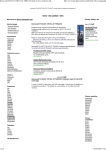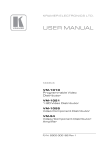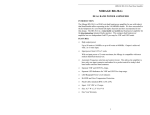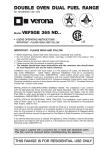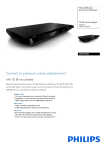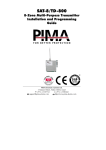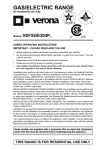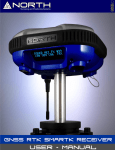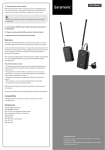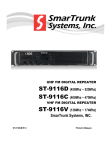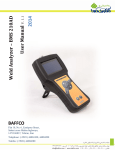Download Kenwood TH-F6
Transcript
Kenwood TH-F6 Conversion modifications YES, IT CAN BE DONE ! TH F6 and TH F7 is, actually, the same transceiver. Well, there is a difference: one diode. Warning: This modification will reset your radio and therefore clear all pre-programmed memories, etc. Please write safely police, aviation and cordless phone frequencies saved in your memory;-) Well, the difference between TH F6 and TH F7 is one diode. If you want to transform your TH F6 into TH F7 or your TH F6 into TH F7, then you may fallow these steps: First open your radio as described in the “MARS/CAP” modification page. After that, locate those three diodes and one resistor located close to the “Power” button. I will call these diodes D1, D2 and D3, starting from “Power” button, followed by the “R” (zero ohm) resistor. Warning: these are NOT notations from Kenwood schematics. On the original Kenwood TH F6 A you will find D1,D2,D3 and R all mounted. To convert your USA F6 model into F7 European model, you must remove the D3 (the one close to the resistor) diode. After modification you will get European ARS on 2m band, no TX on 216Mhz band and all European options (Repeater options, bands, etc.). On the original Kenwood TH F7 E you will find only D1, D2 and R fitted in. To convert your F7 European model into USA F6 model, you must fit in one diode in the “D3” position. After modification you will get TX on 144-148Mhz, TX on 216Mhz, USA ARS on 2m and so on. Warning: transmitting on the 216Mhz band may be illegal in your country. Also your antenna is only dual band, so think twice before pressing that PTT button ;-) All “MARS/CAP” modifications are still available for you’re your new F6/F7 transceiver ;-) Here I will publish a few D1 D2 D3 R configurations I have found... Kenwood TH F6A (TH-F6A THF6A) service menu switch On TH-F6 transceiver, the “Service Menu” is accessible only by opening the transceiver. The “Service Menu” contacts are shown in the following picture, close to the “1” and “4” keys. It is obviously that this design is not very flexible for “daily” use. Maybe this is why people are not (yet) playing too much with “Service Menu” on this transceiver. This is why I decided to build an external switch for “Service Menu”. My best idea was a Reed switch. I bought the smallest one (thanks Good I got two of them ;-) and I started “the best place for Mr. Reed chase”. In the process, one Reed switch died ;-) The best place I have found is shown in the next picture: All you need is two pieces of thin wire and one small Reed switch. After the case is closed, entering the ”Service Menu” is done using a small magnet (from about half inch distance). Using this solution I was able to play with “Service Menu” and find the “low modulation problem” fix. I also think the power level on battery will be interesting to “recalibrate”. I’ll be back in a few days with results… Enjoy ;-) Kenwood TH F6A (TH-F6A THF6A) extended transmit modifications The images in this page are from TH F7E, so please do not be fooled by those small differences in diodes configuration ;-). Warning: This modification will reset your radio and therefore clear all pre-programmed memories etc. Please write safely police, aviation and cordless phone frequencies saved in your memory;-) If you have never removed surface mount devices before, then experiment on some old PCB's first, or even better, on your friend’s TH F6 handheld, before destroying or making a mess of your new radio. If your radios is not new, go ahead, mess it up ;-). Make sure you use a low wattage soldering iron and tweezers to lift the components from the PCB. Or maybe you can use those $2000 SMD soldering devices… If you decide to do this modification, you do entirely at your own risk. However, make sure first you have someone to blame. Have you called your girlfriend today? ;-) 1. Remove the battery from the radio. 2. Remove the grey rubber protective cover from the right hand side of the radio.You DON’T have to remove as in this picture, just free up the SP, MIC and DC IN. If fully removed, will be a little bit hard to fix it back. 3. Remove the black plastic volume and frequency change knobs by gently pulling them vertically. 4. Remove the locking nut from the SMA aerial connector. 5. Remove the locking nut from the frequency change encoder / volume control shaft. 6. With the battery removed, look at the rear of the radio and remove the two screws at the bottom. 7. Now, Doc, let’s open your next victim. It's best to gently open the radio from the bottom until you have a gap of about 10mm. (Nurse, retractor please ;-) Then hold the front panel in the palm of your left hand and gently slide the main body of the radio downwards with your right hand, until the aerial and frequency change encoder shaft are clear of the holes in the top panel of the radio. Take care not to open the radio to fast, because the internal speaker wires are very short. 8. With the radio opened up like a book, look at the left hand side of the PCB just to the left of the PCB mounted microphone. You should see three diodes (if your transceiver is TH F6).In the next picture you will see only two diodes and an open pad, since the picture is from an TH F7E. These photo's shows radio before modification(with the third missing diode, as described above...) 9. Remove only the top diode. There still should be two diodes in the middle and the bottom position. 10. Finally look just below the third diode and find a resistor (zero ohm) to the left of the keypad number "1". This also must be removed to complete the modification. This photo shows radio after modification. 11. Reassemble the radio taking care not to trap the speaker wires and also check that the small joystick and keypad membrane seats correctly. OK That's it... The TH-F7E will now Transmit and Receive in this intervals: [137MHz, 174MHz) [216MHz, 235MHz) [410MHz, 470MHz) Kenwood TH F6A (TH-F6A THF6A) "defective charging jack syndrome" There are many reports about the "defective charging jack syndrome". The charging jack (of early models?) apparently is defective, causing the radio "not to turn on" when the charger is disconnected. Looks like the switch inside the charging jack is broken and not allowing the batteries to re-connect to the radio when you remove the plug. Another theory is that the "F1" battery fuse will open for some reason. Howto fix: 1) Send the transceiver back to Kenwood service, especially if it is under warranty. 2) Try to remove the battery from radio and reinstall it back. 3) You may try (AT YOUR OWN RISK!) to touch a little bit the switch inside the jack using an small screwdriver or a piece of wire. Kenwood TH F6A (TH-F6A THF6A) "external power source/charging syndrome There are a few reports about the Kenwood TH F6A transceiver that stopped working off an external power source and also stopped charging the battery. The transceiver is working ok on the battery. In my opinion, this is a consequence of an "bad design" made by Kenwood engineers. Why? Please read the following scenario: You are using an external antenna and an external power supply on TH F6. Your antenna ground is common with the ground (minus) from your power supply. This may be done from your grounding system or from an second transceiver using the same power supply, or jus by an accidental touch between the antenna’s shield and the case of your secondary transceiver. Now, the best part: when you are using the external power supply jack on your TH F6 A, the transceiver’s connector internal switch will disconnect the battery’s minus from the transceiver’s ground. This way, the battery will remain in the charging circuit and the transceiver will be powered by the external charger/power supply. Having the ground ALREADY connected to the transceiver (from the antenna’s shield), your toy will be powered from the external power supply BEFORE the battery is disconnected. This way, momentary, the battery will be DIRECTLY connected on 12.0-16V, depending on the external voltage ;-) . It will eat A LOT more current from your power supply and the F2 Fuse will open. Hopefully the battery is internal protected ;-). Recomandation: When charging/using an external power supply, FIRST connect the jack to the transceiver, THEN plug the charger/power supply into the wall (this sequence is also described in the user manual, without telling WHY ;-) . When charged, first unplug the charger/power supply from the wall then unplug the power jack from your transceiver. Howto fix: 1) Send the transceiver to your local Kenwood service. 2) Send the transceiver to your local Kenwood service. 3) DO IT AT YOUR VERY OWN RISK ! Well, if you live in Guyana (like me) and don’t have a local Kenwood service, then you may fix the toy for your self ;-). You will need some $2000 soldering devices ;-). If you don’t, you may use your old soldering gun. I’ll not tell you how, you must have the proper skills. If not, find someone with. If can’t find, go to step 1). Now get the schematics. Locate the F1 and F2 fuses in the C2 area. I do not have the PCB schematics, so you must find the fuses: The F1 fuse is located on the same face with the power jack, close to the plus (+) battery contact. Is having “F” on it (at least mine). On the other side of the PCB you will find the F2 fuse, close to the power jack connections. F2 is having the same dimensions like F1, but is having an “S” on it. This fuse must be open. If it is, replace it. I was unable to find one, so I just used a piece of 1.5cm of thin wire, which will do the job. I also used a soft pack from an CPU computer cooler, just to prevent the heated cupper to spread all over the transceiver in case of “huh, id did it again” :-( . Good luck! Waiting for “I did the job” reports Kenwood TH F6A (TH-F6A THF6A) low modulation fix One of the biggest TH F6A problems is the modulation level. Compared with other transceivers, mine is 1/2 in 2m and 1/3 in 70cm, in terms of modulation. One of the low modulation reasons is the microphone design: there is no case opening for mic. Instead, the sound must “travel” from the speaker’s holes, through a little channel, finally finding the mic. Sometimes, during assembly, the channel can be filled with speaker fix glue. Another reason is the “Service Menu” setting. Solutions: 1. Open the transceiver (as described in the MARS/CAP mod page) and check out if the mic channel is clear (using a small piece of wire). If this is not the case or the improvement is not enough (in most cases it will be not! ) go to step 2). 2. Open the transceiver (as described in the MARS/CAP mod page), power on and close the “Service Menu” contacts instantly. The “Service Menu” contacts are located close to the 1 and 4 keys, as described in the following picture. Warning! On the first service menu option, DO NOT press “OK”! You have been warned! Once in the Service menu, press “Right” on the “Multi-scroll key” until you see a line like this: “MAX:?? f1:??”. The “??” will be a hex value between 00 and FE. Now press “BAND” to the desired adjusting band. Turn the “Tuning Control” for a bigger value. Press “OK” on the “Multi scroll key” to set the new value. Check out with your friends, not to get overmodulation. It will be better to make this test with the case closed. Repeat the adjustment for all bands. On my transceiver, the best values are “FE” for 2m band and “51” for 70cm band. That it, do not forget to close the transceiver ;-) Enjoy your new toy ATTENTION The KB2LJJ takes no responsibility for any damage during the modification or for any wrong information made on this modification.







